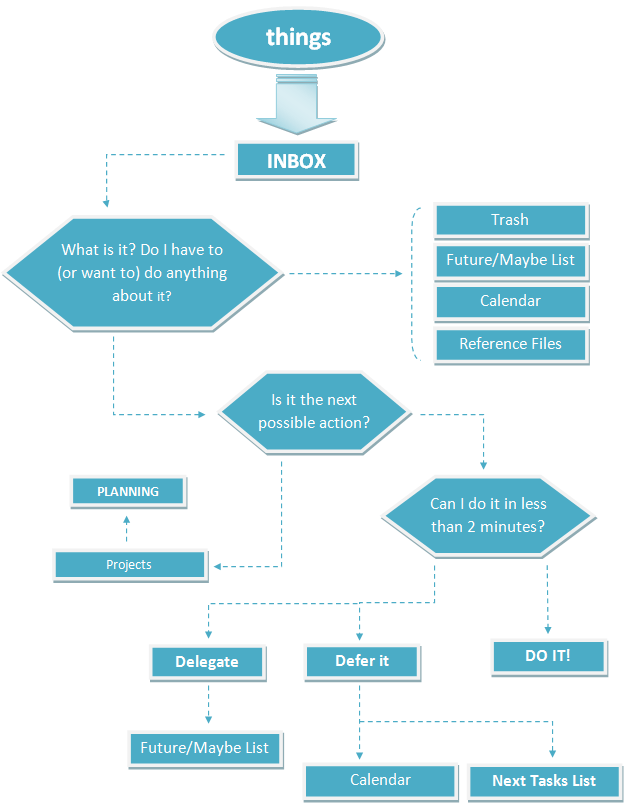But first… At this point you already know what the main elements of productivity are and where to start with GTD. This is all great, but we’re still lacking one important piece of information… What the hell to do with all this stuff?! And today, we’re going to cover exactly that.
Understanding the Diagram of Action
When working with GTD you’re basically doing one of three things at all times:
Take care of defined tasks. Take care of undefined tasks. Plan (define) your tasks.
These things fall into a loop, and repeat themselves throughout the day, week, month, and so on. Planning your tasks will be the topic of the next post in this series, so let’s leave it for now and focus on the first two things.
Defined tasks/activities are everything that’s in your Projects List, Next Tasks List, Future/maybe List, and Calendar. You know, all the stuff you’ve planned to do eventually. Undefined tasks/activities are everything that comes at you by surprise, forcing you to take some kind of action. Like when your spouse calls you and yells that your house is on fire. (That’s an extreme example, but I’m only trying to get my point across.)
Defined and undefined are the only possible types of tasks you might stumble upon on your way through life. Everything is either familiar to you (things you’ve planned for), or new and unexpected (things you didn’t predict would happen). So defined tasks we’ve got covered. Whenever you’re in the mood for work you just pick one from your Next Tasks List and execute it. But what to do when undefined tasks happen? Do we simply do them, or what? This is where the Daily Graph of Activity comes into play.
Getting to Know Your Daily Graph of Activity
First, the graph itself. Don’t get discouraged right from the start because the thing is actually quite easy to grasp — as I’m explaining below.
There’s a thing called things on top of the graph. Things are everything that crosses your path during the day – everything your life hits you with (the undefined tasks). Getting an email is a thing. Coming up with a new idea for something is a thing. Receiving a phone call is a thing. Getting a direct order from your boss is also a thing. In a sentence – everything that requires any kind of reaction on your part is a thing. So the things go into your inbox. The inbox doesn’t have to be an actual inbox, like an email inbox or a traditional mailbox in your front yard. This is simply a place where all the incoming things land. You can create a folder on your computer’s desktop, for example. Or write everything down on sticky notes and stick them to your computer’s screen. Or have a special container next to your desk. The choice is truly up to you. Whatever makes the most sense to you can be used as an inbox. So everything lands there and waits until some further action on your part. What you do is pick something up from the inbox and answer the first question: What is it? Do I have to (or want to) do anything about it? If the answer is no then you have four main options you can do next.
Trashing the thing. Pretty self-explanatory. Putting it in your Future/Maybe List. If you think you might want to work with this thing in the future. Scheduling it in your Calendar. If you need to take action on it on an exact date and time (remember, your Calendar is sacred). Putting it in your Reference Files. If it’s just some piece of information you want to keep, but it’s not actionable in any way.
If the answer is yes then a second question arises: Is it the next possible action? The undefined things you’re hit with during the day can be constructed very differently. They can be simple one-action activities (like an email saying, “Take out the trash”, or they might as well start massive projects (like, “Start the marketing campaign for Coca-Cola”). So the question above is where you decide if it’s the former or the latter. If it indeed is something that sounds like a new project then you need to put it in your Projects List, and then do some planning around it to come up with a list of possible tasks for it (I’ll cover this more in the next post in the series). However, if it is just a simple one-action activity/task then you should consider taking care of it immediately. Hence the third question on the graph: Can I do it in less than 2 minutes? Why the 2 minute restriction? Because if you were to take care of every one-action task someone sends you right at the spot you wouldn’t be able to do anything else in a day. GTD simply protects you against a situation when incoming tasks are sabotaging your way of working. So, if you can indeed do it in less than 2 minutes then simply do it. An example of such a task is one I gave you a couple of paragraphs above – someone telling you to take out the trash. Unfortunately, most undefined tasks cannot be done in less than 2 minutes. That’s just life. There are two choices for you in such a case. You can either delegate them, or defer them.
Delegating something means to simply send it to someone else. Your assistant, your contractor, or whoever else you have to spare or find the thing to be a suitable task for. Once you send the task to them, simply put it in your “Waiting for” List so you don’t forget to get back to that person and ask about their progress. Deferring something means placing it in one of two possible places: either your Calendar or your Next Tasks List.
Put it in your Calendar if it absolutely needs to be done on a specific date, otherwise put it in your Next Tasks List so you can get back to it when you decide to work on your defined tasks. That’s all there is to the graph. Following it honestly lets you handle every undefined task very effectively. Undefined tasks are the ones that can completely ruin your perfectly planned out day; GTD can help you to prevent such a situation.
Now what?
We know what to do with our defined tasks (simply do them when you have some time) and we also know what to do with our undefined tasks (define them as explained above). But there’s one more quick thing I want to share with you today. And that is how to review your work each day/week, and actually be aware of what’s going on. Here’s what I personally do. And that’s it. This whole methodology comes down to these simple activities: And that is why GTD is so effective in a real-life environment. (Photo credit: Decision Making Phrase via Shutterstock)

